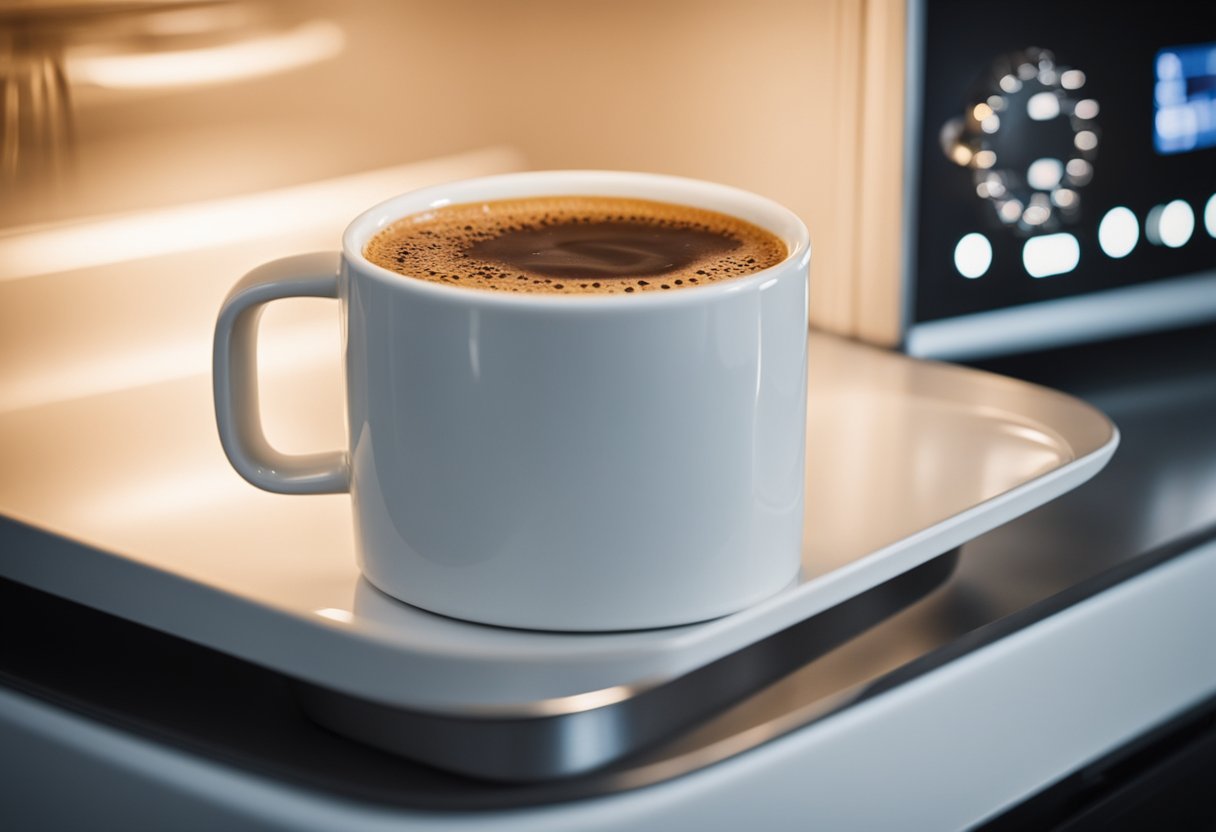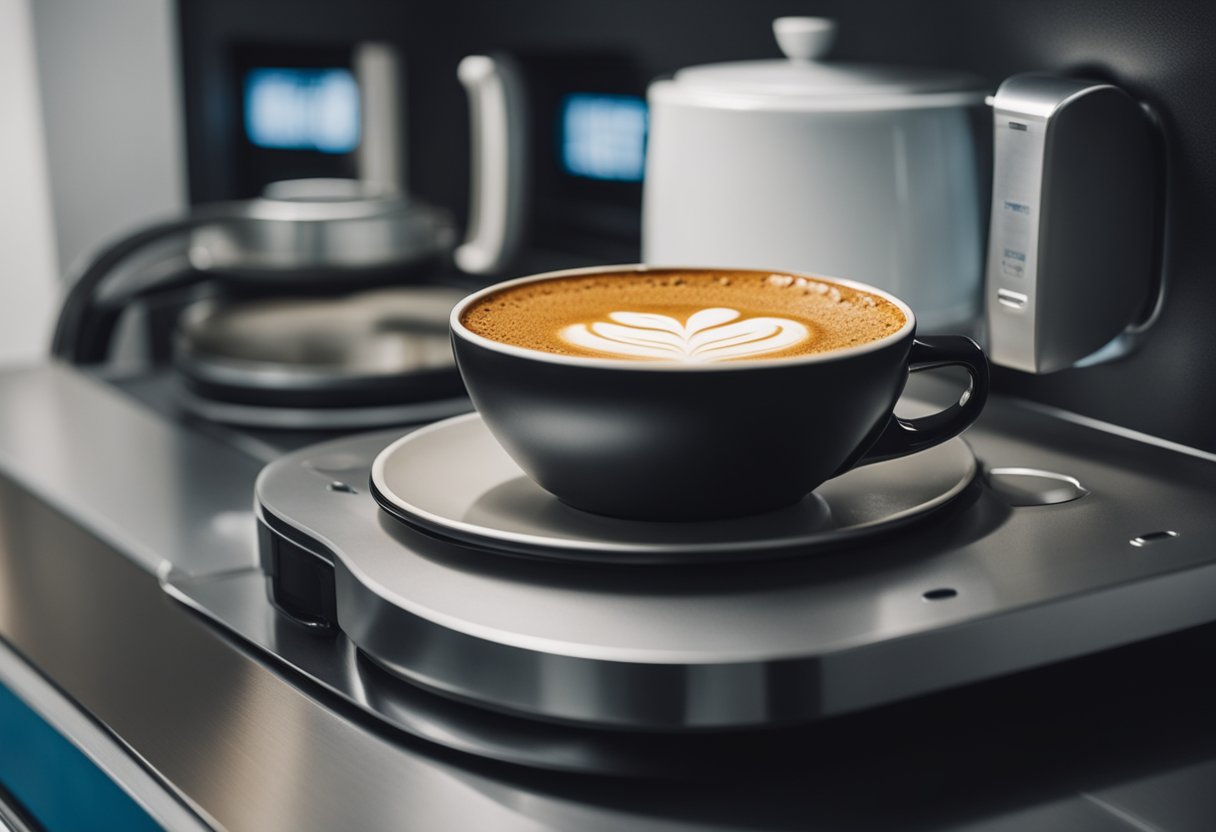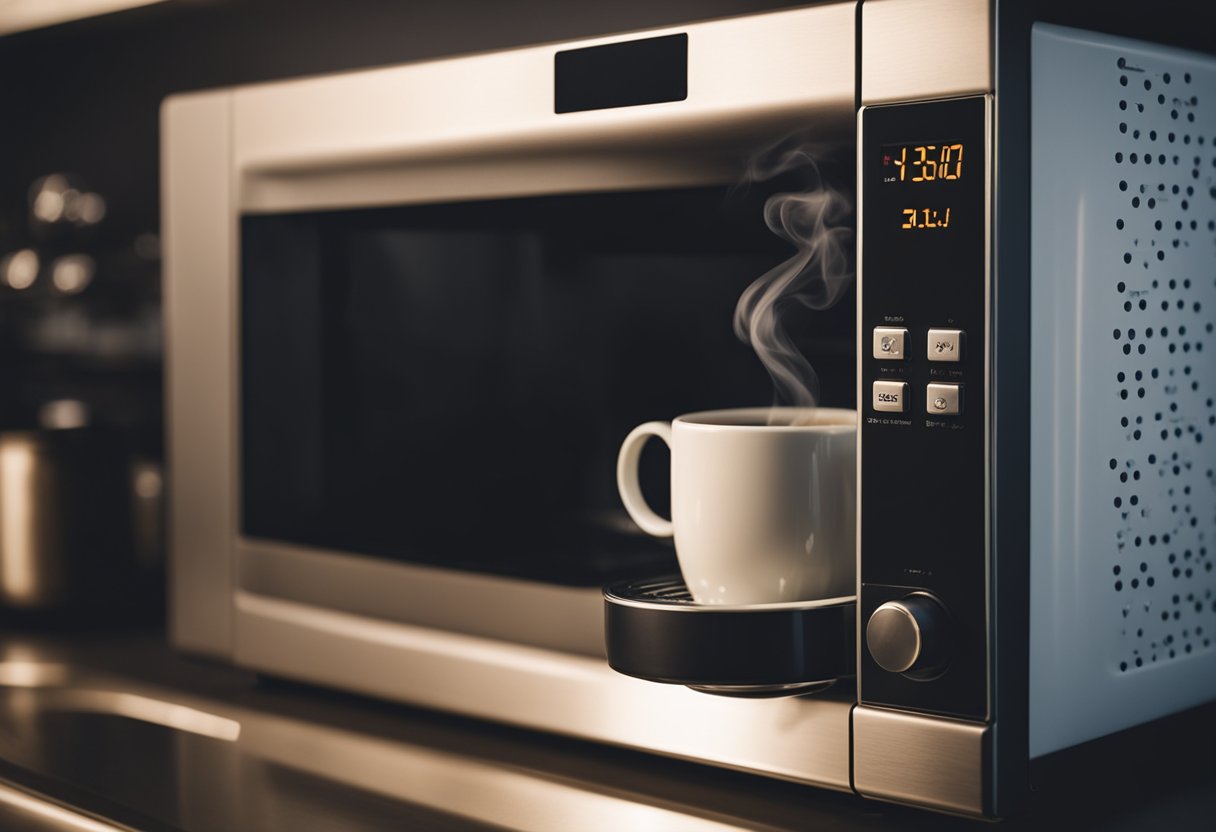As a coffee lover, I understand the heartbreak of having to throw away a perfectly good cup of coffee just because it got cold.
But can you reheat coffee in the microwave? The answer is yes, but with some caveats.

Understanding the basics of reheating coffee is important to ensure that you end up with a warm and flavorful cup instead of a bitter, burnt mess.
The process of reheating coffee in the microwave involves transferring the coffee to a microwave-safe mug, adjusting the microwave settings, and reheating the coffee slowly.
However, it’s important to note that microwaving coffee can destroy some of the flavors and aromas, so the end result may not be as good as a freshly brewed cup.
When it comes to reheating coffee in the microwave, there are some safety considerations to keep in mind. For example, microwaving coffee in a non-microwave safe container can cause it to explode, which can be dangerous.
Additionally, reheating coffee for too long or at too high a temperature can cause it to become bitter and unpleasant. By following some basic guidelines, you can safely and effectively reheat your coffee in the microwave.
Key Takeaways
- Yes, you can reheat coffee in the microwave, but it may not taste as good as a freshly brewed cup.
- Reheating coffee in the microwave involves transferring the coffee to a microwave-safe mug, adjusting the settings, and reheating slowly.
- Safety considerations include using a microwave-safe container and avoiding overheating the coffee to prevent bitterness.
Understanding the Basics

Coffee and Its Components
As a coffee lover, I know that coffee is a complex beverage made up of various components. The main components of coffee are caffeine, chlorogenic acids, quinic acid, and caffeic acid.
Caffeine is responsible for the stimulating effect of coffee, while chlorogenic acids are the primary source of antioxidants. Quinic acid gives coffee its acidic taste, and caffeic acid contributes to the coffee’s aroma and flavor.
Microwave and Its Function
Microwaves are a common household appliance used for cooking and reheating food. They work by using electromagnetic radiation to heat up the water molecules in the food.
The microwaves penetrate the food and cause the water molecules to vibrate, generating heat. The heat then cooks or reheats the food.
When it comes to reheating coffee, the microwave can be a convenient option. However, it is important to note that microwaving coffee can affect its taste and aroma.
The microwave heats up the coffee unevenly, which can cause the coffee to lose its flavor and become bitter. Additionally, microwaving coffee at a high power level can cause the coffee to boil over, creating a mess in the microwave.
To avoid these issues, it is important to know how to properly reheat coffee in the microwave. Adjusting the power level and reheating the coffee slowly can help preserve its taste and aroma.
Additionally, transferring the coffee to a microwave-safe mug before reheating can help prevent spills and ensure even heating.
Reheating Coffee: The Process
When you have leftover coffee, you might be wondering if you can reheat it in the microwave.
The answer is yes, you can, but it’s important to do it properly to avoid ruining the taste and texture of your coffee. In this section, I will explain the process of reheating coffee and the best ways to do it.
Reheating Coffee in a Microwave
Reheating coffee in a microwave is one of the easiest and fastest ways to enjoy a hot cup of coffee again. Here are the steps to follow:
- Transfer the coffee to a microwave-safe mug or coffee cup.
- Adjust the microwave settings to low or medium power and set the timer for 15-20 seconds.
- Check the temperature of the coffee and repeat the process until it reaches your desired temperature.
- Stir the coffee to distribute the heat evenly.
It’s important to note that microwaving coffee can cause it to lose some of its flavor and aroma. To minimize this, it’s best to reheat the coffee slowly and in short intervals.
Alternative Ways to Reheat Coffee
If you don’t have a microwave or prefer not to use one, there are alternative ways to reheat your coffee. Here are some options:
- Stovetop: Transfer the coffee to a small saucepan and heat it over low heat until it reaches your desired temperature. Stir the coffee frequently to prevent scorching.
- Thermos: Pour the coffee into a preheated thermos and let it sit for a few minutes before drinking.
- Hot Water Bath: Place the coffee cup in a bowl of hot water and let it sit for a few minutes until it reaches your desired temperature.
- French Press: Pour the coffee into a French press and heat it over low heat until it reaches your desired temperature.
It’s important to keep in mind that each of these methods has its pros and cons. For example, heating coffee on the stovetop can be time-consuming, while using a French press can be messy.
Choose the method that works best for you and your situation.
In conclusion, reheating coffee is a great way to enjoy a hot cup of coffee again, but it’s important to do it properly to avoid ruining the taste and texture of your coffee.
Whether you choose to use a microwave or an alternative method, follow the steps carefully and enjoy your delicious coffee!
Effects of Reheating on Coffee
When it comes to reheating coffee, there are a few things to keep in mind. In this section, I will discuss the effects of reheating on coffee and what happens to the taste and aroma of coffee when it is reheated.
Taste and Aroma Alteration
One of the most noticeable effects of reheating coffee is the alteration of its taste and aroma. When coffee is reheated, it can become bitter and lose some of its flavor profile.
This is because the reheating process can cause the coffee to oxidize, which creates a sour taste and reduces the aroma.
The bitter taste in reheated coffee is due to the breakdown of chlorogenic acids into quinic and caffeic acid. These compounds are responsible for the bitterness in coffee.
When coffee is reheated, the chlorogenic acids break down further, resulting in a more bitter taste.
Chemical Changes in Coffee
When coffee is reheated, there are also chemical changes that occur. These changes can alter the chemical makeup of the coffee and affect its taste and aroma.
One of the most significant changes that occur is the breakdown of the coffee’s flavor compounds.
The breakdown of flavor compounds is due to the high heat used during the reheating process. The heat can cause the coffee’s chemical makeup to change, resulting in a loss of flavor and aroma.
Additionally, the reheating process can cause the coffee to lose some of its acidity, resulting in a flatter taste.
In conclusion, reheating coffee can alter its taste and aroma due to chemical changes that occur during the reheating process.
The coffee can become bitter and lose some of its flavor profile, resulting in a less enjoyable cup of coffee. Therefore, it is recommended to brew a fresh cup of coffee instead of reheating the old one.
Safety Considerations
Is It Safe to Reheat Coffee?
As a coffee lover, I understand the desire to reheat a cup of coffee that has gone cold. But the question remains: is it safe to reheat coffee in the microwave?
The answer is yes, as long as you take certain precautions.
One of the primary concerns with reheating coffee in the microwave is the risk of burns. When coffee is heated, it can become superheated, meaning it is hotter than its boiling point.
This can cause the coffee to erupt, potentially causing burns. To avoid this, it is important to use a microwave-safe container and to heat the coffee in short intervals, stirring in between to distribute the heat evenly.
Another concern is the potential for mold growth. If coffee is left out for too long, it can become a breeding ground for mold.
When you reheat the coffee, you are essentially giving the mold a chance to grow and spread. To avoid this, it is important to refrigerate any leftover coffee and to reheat it within a reasonable amount of time.
Microwave-Safe Containers
When reheating coffee in the microwave, it is important to use a microwave-safe container. This means avoiding plastic cups and styrofoam cups, as they can release harmful chemicals when heated.
Instead, opt for a ceramic mug or a microwave-safe glass container.
Ceramic mugs are a popular choice for reheating coffee in the microwave because they are microwave-safe and retain heat well.
However, it is important to note that not all ceramic mugs are created equal. Some ceramic mugs may contain lead or other harmful materials, so it is important to choose a high-quality, lead-free ceramic mug.
In summary, reheating coffee in the microwave is safe as long as you take certain precautions. Use a microwave-safe container, heat the coffee in short intervals, and refrigerate any leftover coffee to avoid mold growth.
Opt for a high-quality, lead-free ceramic mug or a microwave-safe glass container. By following these guidelines, you can enjoy a hot cup of coffee without any safety concerns.
Handling Leftover Coffee
As a coffee lover, I often find myself with leftover coffee that I don’t want to go to waste. If you’re like me, you might be wondering what to do with leftover coffee. In this section, I’ll cover some tips for storing and using leftover coffee.
Storing Leftover Coffee
If you have leftover coffee, you don’t want it to go bad. The best way to store leftover coffee is to put it in an airtight container and store it in the fridge.
This will keep it fresh for a few days. If you want to store it for longer, you can freeze it in an ice cube tray and use it for iced coffee later.
Using Leftover Coffee
There are many ways to use leftover coffee. Here are a few ideas:
- Make iced coffee: Pour your leftover coffee over ice and add creamer, sugar, or milk to taste. This is a great way to use up leftover coffee on a hot day.
- Make cold brew: If you have a lot of leftover coffee, you can make cold brew. Simply add water to your leftover coffee and let it sit in the fridge overnight. In the morning, strain the coffee and enjoy.
- Make a coffee scrub: Mix leftover coffee grounds with coconut oil or sugar to make a natural exfoliating scrub.
- Make a marinade: Use leftover coffee as a base for a marinade for meat. The acidity in the coffee will help tenderize the meat and give it a unique flavor.
- Make a hot cup of joe: If you have leftover hot coffee, you can reheat it in the microwave or on the stove. Just be sure to reheat it slowly to avoid burning it.
Overall, leftover coffee doesn’t have to go to waste. With a little creativity, you can find many ways to use it up.
Conclusion

In conclusion, reheating coffee in the microwave is a safe and convenient way to enjoy your coffee again. However, it is important to reheat it slowly and in a microwave-safe mug to avoid any potential hazards.
The best way to reheat coffee in the microwave is to transfer it to a microwave-safe mug, adjust the microwave settings to low or medium, and reheat the coffee for 30 seconds to a minute, depending on how much coffee you have.
While some people believe that microwaving coffee destroys caffeine, this is not true. Microwaving coffee does not affect the caffeine content, but it can affect the flavor and aroma of the coffee.
To preserve the flavor and aroma of your reheated coffee, it is best to add a splash of fresh coffee or water to dilute it. This will help to bring out the full flavor of the coffee and make it taste fresher.
Overall, reheating coffee in the microwave is a quick and easy way to heat up cold coffee. It does not require any additional equipment or utensils, and it preserves the flavor and aroma of the coffee better than other methods.
Frequently Asked Questions
Can you reheat coffee the next day?
Yes, you can reheat coffee the next day. However, it is important to store it properly in the refrigerator to prevent bacterial growth.
When reheating, make sure to use a microwave-safe container and heat the coffee in 30-second intervals to avoid overcooking.
Does reheating coffee cause cancer?
No, reheating coffee does not cause cancer. According to the American Cancer Society, there is no evidence that microwaving or reheating coffee can cause cancer.
Microwaving coffee carcinogenic?
No, microwaving coffee is not carcinogenic. The World Health Organization has stated that microwaving food is safe, as long as the microwave is used properly and the food is heated to the appropriate temperature.
How to microwave coffee?
To microwave coffee, transfer it to a microwave-safe mug or container. Heat the coffee in 30-second intervals, stirring in between each interval to ensure even heating. Avoid overheating the coffee, as this can cause it to taste burnt.
Can I microwave coffee cup?
It depends on the material of the coffee cup. Glass, ceramic, and microwave-safe plastic cups can be microwaved, but metal cups should not be microwaved.
Always check the label or manufacturer’s instructions to ensure that the cup is microwave-safe.
How to reheat coffee?
To reheat coffee, transfer it to a microwave-safe container and heat it in 30-second intervals, stirring in between each interval. Alternatively, you can reheat the coffee on the stove or in a French press.







